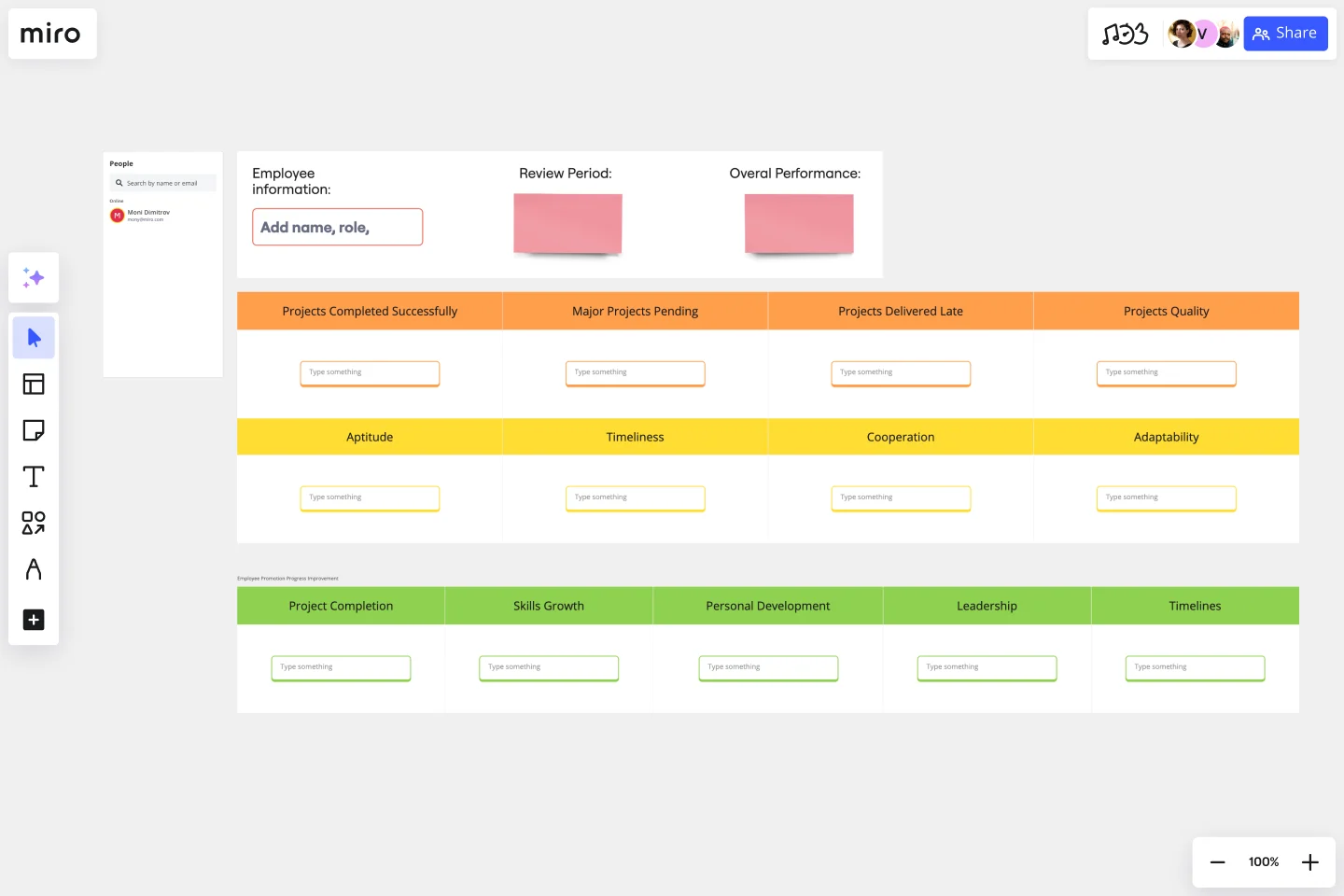Performance Review Template
Streamline your framework for evaluating an employee's contributions and growth with the Performance Review Template. Promote clear communication, align expectations and create a shared understanding of performance outcomes.
About the Performance Review Template
At Miro, we understand the significance of structured feedback in the growth and development of people and organizations. So, we introduce our Performance Review Template—a tool designed to make evaluation processes seamless, insightful, and collaborative.
What's a Performance Review Template?
A Performance Review Template is a structured framework managers and HR professionals use to evaluate an employee's performance over a specific period. It helps in highlighting achievements, identifying areas of improvement, and aligning individual goals with the company's. The benefits of using a Performance Review Template include:
Structured feedback: Ensures that evaluations are consistent, objective, and based on set parameters.
Clear communication: Provides open dialogue about career progression, expectations, and achievements between employees and supervisors.
Continuous growth: Helps identify areas of improvement and aids in setting clear benchmarks for future evaluations.
How to use the Performance Review Template in Miro
The Performance Review Template is designed for a thorough evaluation while remaining easy to use:
1. Employee Data
Begin with the foundation:
Name: Clearly mention the employee's full name for proper identification.
Position: Specify the employee's role or designation within the organization.
Review Period: Indicate the time frame for which the review is being conducted.
Overall Performance: Provide a general assessment or rating encompassing the employee's performance over the review period.
2. Projects
Dive into a detailed review of the projects the employee has been involved in:
Projects successfully completed: Highlight the projects that were accomplished successfully and met the expectations.
Major projects pending: List important tasks or projects that are still in progress or awaiting completion.
Projects delivered late: Point out any tasks or projects that missed their deadline.
Projects quality: Evaluate and describe the overall quality of the projects the employee handles, focusing on accuracy, thoroughness, and alignment with company standards.
Aptitude: Discuss the employee's ability to grasp new concepts, solve problems, and their overall skill set relevant to their role.
Timeliness: Evaluate the employee's punctuality, ability to meet deadlines, and overall time management skills.
Cooperation: Delve into how well the employee works within teams, their willingness to assist colleagues, and their overall collaborative spirit.
Adaptability: Assess the employee's flexibility in the face of changes, how they handle new challenges, and their openness to evolving job requirements.
3. Employee Promotion Progress Improvement:
Understand and evaluate the employee's growth trajectory:
Project Completion: Analyze their consistency and efficiency in wrapping up projects.
Skills Growth: Identify improvements in their skill set and where there's room for development.
Personal Development: Look into their self-improvement efforts and personal growth in the context of the company's needs.
Leadership: Assess their leadership qualities, including taking the initiative, mentoring, and their ability to guide and inspire teams.
Timelines: Evaluate their consistency in adhering to timelines, planning projects, and forecasting completion dates accurately.
Using the Miro Performance Review Template, managers can capture a holistic view of an employee's strengths, areas of improvement, and overall contributions to the organization.
Can the template be customized to fit our organization's specific needs?
Yes, the Performance Review Template is flexible and can be adjusted to align with your company's specific review criteria and guidelines.
How can multiple reviewers provide feedback on the same template?
Miro allows collaborative input. Simply share the board with other reviewers; they can add their insights directly onto the template.
Can I use this template for team reviews or only individual evaluations?
While the template is primarily designed for individual evaluations, it can be adapted for team reviews by adjusting the parameters to fit team-based achievements and challenges.
How do I save or archive completed reviews for future reference?
Reviews can be easily saved within Miro. You can also export them for archival purposes or integrate with your HR management software.
Get started with this template right now.
One-on-one Meeting Template
Works best for:
Meetings
Ensure your meetings are productive by using a one-on-one meeting template. Create and stick to your agenda items, understand what’s going well, what isn’t working, and how to improve. Discuss what’s been accomplished and what’s still in progress.
About Me Template
Works best for:
Meetings, Operations, Management
The About Me Template is a comprehensive tool designed to help individuals compile and present both personal and professional details. One of its standout benefits is the structured format, which not only ensures a polished and professional appearance but also lets users convey their narratives with clarity and consistency, making a memorable impression on viewers.
